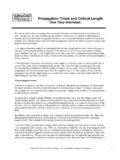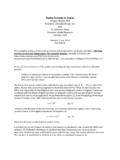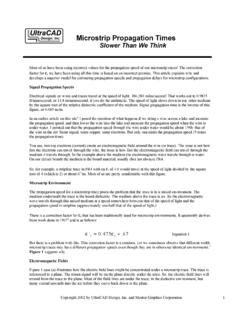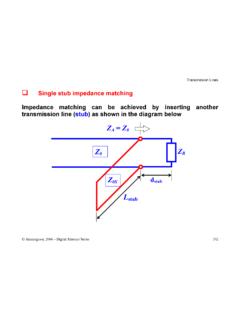Transcription of Transmission Line Terminations - UltraCAD
1 Transmission line Terminations It s The End That Counts! 1 In previous articles1 I have pointed out that signals propagating down a trace reflect off the far end and travel back toward the source. These reflections can cause noise, and therefore signal integrity problems. These reflections can be controlled if we design our traces to look like Transmission lines. Then, for long traces (those longer than the critical length) we can control reflections using Transmission line termination techniques. This paper describes the five most common types of termination techniques used on printed circuit boards. As suggested in the first of the referenced papers, the ideal model of a Transmission line is one that is infinitely long. If we take just a portion of that line , and terminate it in its characteristic impedance, it still looks infinitely long when viewed from the front (Figure 1).
2 And, there is no reflection from the far end. If we terminate a Transmission line in anything other than its characteristic impedance, a reflection will occur. The magnitude of that reflection can be determined from a parameter known as a reflection coefficient, . The reflection coefficient, , is calculated as: where RL, the load resistor, and Zo, the characteristic impedance of the Transmission line , are as shown in Figure 2. It can be observed that the reflection coefficient has a value between 1 and +1. If the trace is left open circuited, the reflection coefficient is +1 and there will be a 100% reflection back toward the Copyright 2002 by UltraCAD Design, Inc. and Mentor Graphics Corporation Zo Figure 1 If we terminate a portion of a Transmission line in its characteristic impedance, it still looks infinitely long. ZoRL Zo Figure 2 The magnitude of the reflection is determined by the relationship between RL and Zo Transmission line Terminations It s The End That Counts!
3 2 driver. If the trace is shorted, the reflection coefficient is 1 and there will be a 100% reflection of the opposite sign back toward the driver. If the line is terminated with a resistor whose value is the same as the characteristic impedance of the trace (Zo), the reflection coefficient is zero and there will be no reflection at all. It should be noted that if a reflection does occur, and propagates back to the driver (source), it can reflect again off the source. The driver has an output impedance. If that output impedance is exactly equal to Zo, then there will be no further reflection from the source. But if the output impedance of the driver is different than Zo, an additional reflection will occur. The magnitude of that reflection is again determined by a reflection coefficient. Simply substitute Rs, the output impedance of the driver, for RL in the reflection coefficient formula.
4 UltraCAD has created a simple Transmission line Simulator that can illustrate these reflections under different conditions (Figure 3). It is described in the Appendix and is freely available for download from UltraCAD s web site. Although when we talk about Terminations and reflections we usually talk about a single resistor at the end of the trace, there are actually five common termination techniques seen in typical These are summarized in Figure 4. Figure 3 UltraCAD s Transmission line Simulator Transmission line Terminations It s The End That Counts! 3 VccR1R2 RVccRL RL C AC Pros: Performs as well as parallel without the dc power drain Cons: C is difficult to optimize Requires 2 components Can lead to timing problems Parallel Pros: Terminate to either Gnd or Vcc R easy to determine Only one additional component Performs well with distributed loads Cons: Power dissipated in RL at all times Power requirement high Thevenin Pros: Properly chosen, pull up/down resisters can improve noise margins Performs well with distributed loads Cons: Results in steady flow of current through R s Optimum selection of R1 and R2 can be complicated Complicated if used with tri-state devices Series Pros: One component No dc load Cons: Can be difficult to optimize RS There IS a reverse reflection.
5 Diode Pros: Does not depend on Zo Little increase in power Can be placed anywhere on line Cons: reflections still exist Requires 2 devices Diodes must be FAST with low foreword voltage Figure 4 The five most common termination strategies. R2 R1 RS Transmission line Terminations It s The End That Counts! 4 Parallel termination : The first of these is the most intuitive and possibly the most common. It is called parallel termination and simply consists of a single resistor from the trace to ground (or to Vcc). It is the technique we have been referring to throughout this paper so far. This technique has several advantages: (1) the value of the resistor is relatively easy to determine, (2) there is only a single component, (3) it is easily connected, and (4) it performs well with distributed loads ( loads that are distributed along the trace.) There is only one drawback to this type of termination : it provides a continuous DC path to ground.
6 Therefore, continuous DC current can flow through it at all times. This may or may not be an issue for a single trace. But if your design has a thousand or so impedance controlled nets, the total power dissipation in a thousand terminating resistors can become quite significant! Thevenin termination : A closely related variation of the parallel termination strategy is the Thevenin termination . This consists of a pair of resistors, one going to ground and one going to Vcc. The pair of resistors provide a pull-up/pull-down function as well as a termination function. Therefore, it can improve noise margins in certain situations, and performs as well as the parallel termination with distributed loads. On the one hand, it would appear that the selection of resistor values would be relatively straightforward. The parallel combination of the two resistors must simply equal Zo, or: But Ethirajan and Nemec2 show that there is an optimum value for R1 and R2 based on the specific characteristics of the driver.
7 The optimum values for R1 and R2 primarily optimize (minimize) the power dissipated in the circuit. This optimum value can be difficult to determine. Other drawbacks to this strategy include the addition of an additional component, and the fact that DC current still flows through the resistor pair at all times. And this strategy is only well suited for bipolar (two-state) devices, not for tri-state logic families. Some people have reported that there can be an EMI problem with this termination strategy. Note that there are different currents flowing between Vcc and Gnd, through R1 and R2, depending on the logic state. And this current changes at the same rate (di/dt) as the logic state changes (the rise/fall time of the signal). In this respect, the two resistors look exactly like a switching logic gate. Therefore, they might need to be decoupled (with bypass capacitors) just as a logic gate might need to be decoupled (with bypass capacitors).
8 The issue really is related to loop areas and currents, which are one of the primary causes of EMI. Thus, you may occasionally hear people say that Thevenin Terminations may also require decoupling capacitors in order to quiet down EMI emissions. AC termination : Yet another variation is the addition of a capacitor in series with the parallel terminating resistor. The primary advantage of this is that the capacitor blocks DC current, so there is no steady-state current flowing through the termination . At first glance it would appear that this strategy otherwise has all the advantages of the parallel termination strategy. However, the cost of this, of course, is the added component. 11112 ZoRR=+ Transmission line Terminations It s The End That Counts! 5 But there are some subtle and some not-so-subtle problems with AC termination . If a large capacitor value is used, there can be considerable power dissipation and the strategy is little different from normal parallel termination .
9 If a very small capacitor is used, it will cause overshoot and may interfere with the rise and fall times of the signal. There are some subtle interactions that take place with AC termination using a small capacitor. As the voltage across the terminating resistor changes, the current through the capacitor changes. This causes the capacitor to charge or discharge with an RC time constant related to the component values. If the time constant is too short, the capacitor charges during the half-cycle and the voltage at the receiver changes accordingly. Figure 5 illustrates this effect. Figure 5(a) shows the waveforms associated with a relatively large capacitor. The scope is a HyperLynx simulation of a 50 Ohm Transmission line , 5 ns long, terminated with a 50 Ohm resistor in series with a .002 uF capacitor. The green line is the driver voltage. The red line , trailing 5 ns later, is the voltage at the receiver (and at the resistor).
10 The blue line is the voltage across the .002 uF capacitor. As can be seen, the waveforms look very clean. Figure 5(b) illustrates the same simulation with a 200 pF capacitor (.0002 uF). Note that there is overshoot and undershoot in the receiver waveform. Each transition of the driver signal is followed 5 ns later with the same (magnitude) transition at the receiver. But then the receiver voltage continues to rise (or fall, as the case may be) as the capacitor charges and discharges. If this over/undershoot is severe enough, logic errors may result. Note that this is not a reflection. This is not an impedance matching issue. It is a changing reference voltage that shifts the value of the waveform at the receiver. As is seen, the driver signal is still relatively clean. In extreme cases the voltage at the driver may also start to change. But again this is better classified as a shifting reference rather than an actual reflection.











